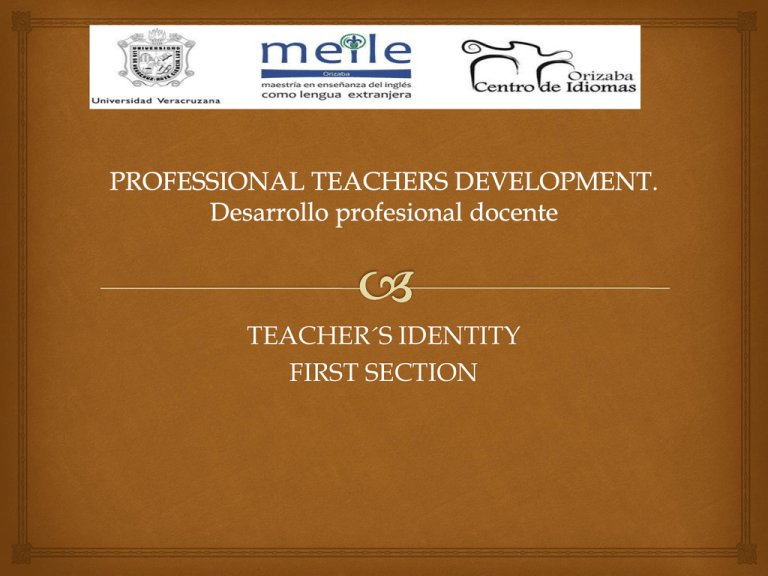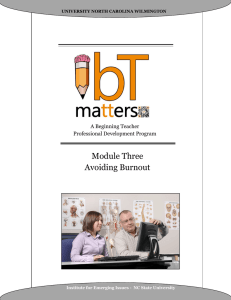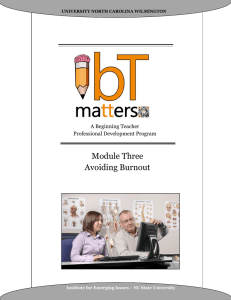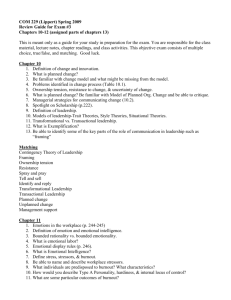TEACHER´S IDENTITY FIRST SECTION
advertisement

TEACHER´S IDENTITY FIRST SECTION My identity Is it easy for you to say what is your identity? Video: Octavio Paz According to the video´s definition of human being Why is so difficult to interact in our classes? Do you know who is the other? What do authors mean by otherness? Read the article: What is my background? What is my identity? Write down your biography: a) Personal b) Academic Teacher´s identity Do you consider yourself a transcultural person? Why? Learning to Teach: The Construction of Teacher Identity in the Context of Schools:Margaret Walshaw/Jan Savell (Massey University) Why brother with professional development? Professional development is related to: How do you improve your teaching? How do you learn yourself as a teacher? How are you able to manage changes? How can I related with my colleagues (team-teaching)? Can I trust on them? How can I mange my group? So on… Now, work in pairs and before reading about teachers development, try to define it. Defining is a term used in Dale Lange: “Teachers development literature to describe a process of continual intellectual, experiential, and attitudinal growth of teachers” (1990). “The intent here is to suggest that teachers continue to evolve in the use, adaptation, and application of their art and craft” (Lange) TASK: Work in groups of four and answer the following questions: 1. What factors promote professional development as a lifelong process? 2. What elements are necessary for it to occur? Make a list of the factors you think must be present for professional development to take place. Compare your answers with Andy´s ideas Professional development happens if only if, we choose to. The motives may differ from teacher to teacher, but this we have in common: no choice, no way. Trust is another important issue for me, which goes hand in hand with openness and honesty. Some sense of mutuality or reciprocity is also important for me. No mater how much older, wiser, more published, more securely tenured the teachers may be who are helping me, I think they should be able to identify what they have learned from me too. Knowing that changes need to be made in order to bring about “better” and “more” learning (my own as well as my students´) is not the same as making those changes. For example: I might realize that I need to increase my student´s motivation, but not know how to do this! Be aware of what is evaluation-driven and teacher development “ I decide if, when, why and how I develop, contract renewal or no contract renewal”. (Andy Curtis) What is teachers development? Video: Why professional development…? http://www.youtube.com/watch?v=TH6BpP21Cuc REASONS FOR PURSUING PD. 1. To acquire new knowledge and skills 2. Change (we need to be ready to cope with new changes – governmental regulations or policies) 3. Increase in income or prestige 4. Empowerment (working out our won way forward, based on our own understanding – Edge, 1992--) Teacher´s burnout Have you ever felt burnout? Talk to your partner and discuss what do you think is to be burnout? When could this happen? Now read the article about burn out. “Talking about frustration” (pages 8-10) Were your ideas right? The Maslach Burnout Inventory uses a three dimensional description of exhaustion, cynicism, and inefficacy. Important concepts and ideas. Concept from the early 70´s Final flickering flame, of a charred empty shell, of dying embers and cold, gray ashes Emotional exhaustion, depersonalization, and reduce personal accomplishment that can occur among individuals who do “people work” A function of the many stress felt by individuals in both their social life and their work experience. Powerlessness Lack of enthusiasm to prepare lessons/lack of interest in the subject Loss of energy, loss of memory How to manage Burnout? In general, resting proves to be very effective. This may include a temporary reduction of working hours, slowly rebuilding the endurance of the individual. In his book, Managing stress: Emotion and power at work (1995), Newton argues that many of the remedies related to burnout are motivated not from an employee's perspective, but from the organization's perspective. Despite that, if there are benefits to coping strategies, then it would follow that both organizations and individuals should attempt to adopt some burnout coping strategies. 12 Strategies Employee assistance programs (EAP) Stemming from Mayo's Hawthorne Studies, Employee Assistance Programs were designed to assist employees in dealing with the primary causes of stress. Some programs included counseling and psychological services for employees. There are organizations that still utilize EAPs today, but the popularity has diminished substantially because of the advent of stress management training (SMT). Stress management training Stress Management Training (SMT) is employed by many organizations today as a way to get employees to either work through stress or to manage their stress levels; to maintain stress levels below that which might lead to higher instances of burnout. Stress interventions Research has been conducted that links certain interventions, such as narrative writing or topicspecific training to reductions in physiological and psychological stress. Individual aspects Problem-based coping On an individual basis, employees can cope with the problems related to burnout and stress by focusing on the causes of their stress. Various therapies, such as Neurofeedback therapy, claim to assist in cases of burnout. This type of coping has successfully been linked to reductions in individual stress. Appraisal-based coping Appraisal-based coping strategies deal with individual interpretations of what is and is not a stress inducing activity. There have been mixed findings related to the effectiveness of appraisal-based coping strategies. Social support Social support has been seen as one of the largest predictors toward a reduction in burnout and stress for workers. Creating an organizationally-supportive environment as well as ensuring that employees have supportive work environments do mediate the negative aspects of burnout and stress. Dairy



